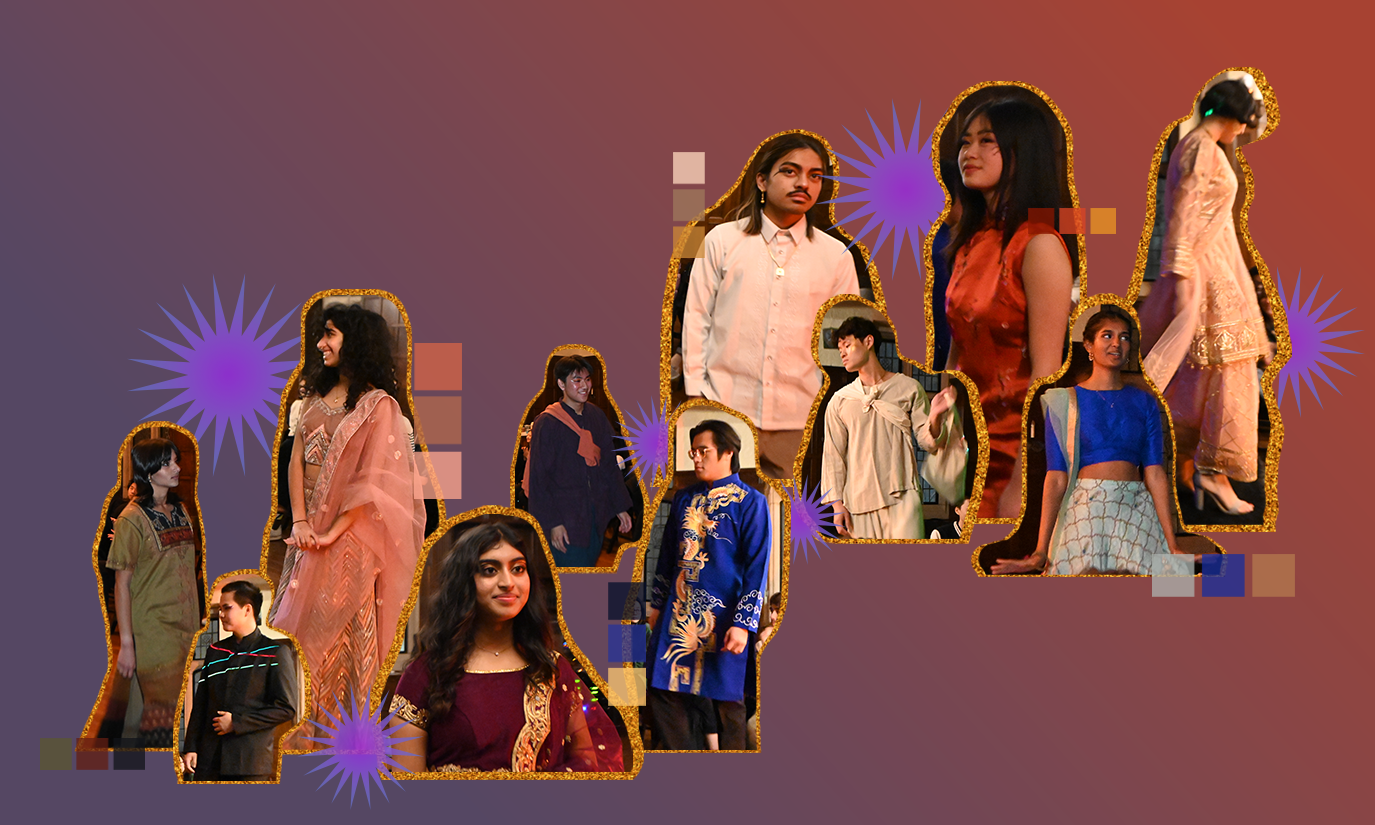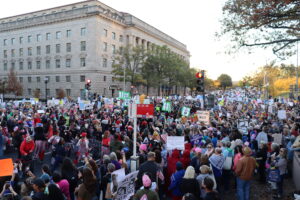Everyday fashion at Georgetown is the dark blue quarter-zip, khaki pants, and collared shirt uniform. It can be expensive, but rarely glamorous or awe-inspiring. But on a regular Saturday night, in a room usually used to host guest lecturers, Georgetown was graced with the artistry and elegance—and glamor, of course—of Asian cultural wear.
On Feb. 25, Georgetown’s Asian American Student Association (AASA) hosted its second-ever cultural fashion show, Runway ASIA, in the Copley Formal Lounge. Runway ASIA was organized by Aidan Ng (SFS ’25) and Giselle Rasquinha (CAS ’25), who currently serve as AASA’s Political Advocacy Committee co-chairs. The show aims to fulfill a dual purpose of inspiring Asian activism and celebrating Asian joy by creating a safe and accessible space for creative expression, while also acting as a fundraiser. This year, all proceeds from ticket sales were donated to earthquake relief funds in Turkey and Syria.
“ASIA stands for Asian Style Inspires Activism, because it leads into our fashion show being used as a tool to raise awareness about an issue, but also just the importance of fashion in Asian culture,” Rasquinha said.
Runway ASIA wasn’t structured like your typical runway experience. After walking, models were given the opportunity to speak to the audience, introduce the clothing they were wearing, and share the historical and personal meaning behind it. Also atypical was the complimentary cotton candy—unexpected, but highly appreciated.
A stunning range of cultural wear was showcased, with styles originating from all over Asia. The striking gold dragon on a Vietnamese áo gấm was bold, and the sparkling embellishments of the Indian lehenga were intricately woven. Above all else, the show was touching and welcoming—many, if not all, of the outfits modeled were likely worn prior at family gatherings, danced in at cultural holidays, and inseparably tied to pivotal moments in people’s lives.
When having conversations about what culture is and consists of, the importance of fashion often isn’t explicitly articulated, but it is truly unparalleled. Throughout many Asian cultures, traditional festivities are always inseparable from cultural wear.
The lehenga, for instance, is a timeless example of the beauty and diversity of South Asian culture, and an outfit Rasquinha wore to Georgetown’s Kartik Mela celebration. In her experience, her cultural clothing is both a bridge to community and a connection to heritage.
“Seeing yourself actively partaking in your culture and seeing so many people around you who are also just as excited to celebrate, the feeling of belonging that comes with that is a very, very special thing,” she said. “It’s one of those rare moments where I can feel authentically Indian and authentically Asian.”
Fundraisers are a conventional way to enact social change, but Runway ASIA also redefined what advocacy is and can be by embracing fashion as its own inherent and unique form of advocacy.
Linh Truong (CAS ’24) is a second-generation Vietnamese American. While not directly involved in the coordination of Runway ASIA, Truong is a creative and designer—and is involved in multiple AAPI causes and content creation. Drawing from her experiences, she sees a direct intersection between fashion and social impact.
“Anything you make and anything you wear, especially in places where it’s not welcome, is a form of protest, is a form of resistance,” Truong said.
Similarly, Rasquinha views Runway ASIA as an explicit event of defiance. For most people, fashion doesn’t serve a particularly profound purpose. However, in a place where your identity is in the minority, to freely wear something that is a direct extension of your cultural background is empowering.
“I think oftentimes a lot of people, when they come to America, will do their best to assimilate in any way that they can in order to compensate for the fact that they don’t look like everyone else, that you feel like a minority, visibly,” Rasquinha said. “So I think the idea of putting on a fashion show and being able to proudly wear your culture’s clothing in front of everyone and to take pride in it is something that’s really unique, that I don’t think is done very often in spaces, especially in a PWI like Georgetown.”
Lorenzo Pagdanganan (CAS ’23), who walked in Runway ASIA for a second year, believes that showcasing cultural wear is its own type of advocacy. “Having an event around cultural wear is a very outspoken way of showing identity and community in a way that you don’t normally see every day, especially at Georgetown, and in and of itself it is activism,” he said.
At Georgetown and beyond, there is a lack of performance spaces for Asian Americans. Ng, who comes from a theater background, noticed that AAPI underrepresentation persists in creative industries writ large. This lack of representation is a national trend—in the 2016-2017 Broadway season, only five percent of all plays and musicals produced were written by minority playwrights, and none were written by Asian American playwrights—that is reflected at Georgetown.
“If you asked me last year to name three Asian American performance groups, I wouldn’t be able to name one,” he said.
But complacency doesn’t have to be the norm—when there aren’t spaces that feel welcoming, the answer for Runway ASIA is to create your own.
“There’s just a lot less Asian American representation in those spaces, and a lot of it comes down to members of our community not feeling themselves being seen in those spaces, and being discouraged from pursuing those spaces. And so now that we’re in college, Giselle and I just wanted to create that space where we can be seen,” said Ng.
There is a subtler message around the portrayal of events geared towards AAPI audiences that Runway ASIA also seeks to change—a complex and underlying tension that often goes unmentioned. The show seeks to challenge the societal tendency to perceive the Asian American experience exclusively through the lens of discrimination.
“Community spaces for marginalized groups, and also with that the AAPI community, are centered a lot on discussions of oppression, discussions of how your identity fits into campus. And I think a lot of the time it focuses on feelings of marginalization,” Rasquinha said.
It can be easy to feel like one’s identity is solely recognized in relation to discrimination—students of underrepresented groups are often only asked to share their stories and perspectives when they relate to acts of injustice. Runway ASIA doesn’t trivialize that gravity. Rather, it’s simply a testament that advocacy doesn’t always have to be heavy or a fight for one’s rights; it can also be celebration.
As many attendees and models noted, joyful spaces like Runway ASIA are priceless and comforting. “The center premise of Runway ASIA is to highlight your culture,” Rasquinha said. “It’s to show how unique and beautiful and important it is. We’re just saying, ‘This is a part of who I am, it’s beautiful, and this is something that I want to show everyone.’”
These creative spaces give AAPI communities a freedom not just to showcase culture, but to reinterpret it. That reinterpretation was present on the runway: While some outfits were formally dressed in accordance with how the clothing was historically worn, others were styled with makeup and accessories to add a modern flair.
Pagdanganan pointed out that while his outfit this year was conventionally more “formal and traditional” than last year’s, he doesn’t see these categorizations as immutable. “Tying cultural aspects and not even just clothing, but specific cultural things, to tradition is sort of limiting,” he said. “Everyone can have their own connection to traditions in their own way, and then personalize it.”
He chose to personalize and complete his look by accessorizing with delicately handmade Filipino gold jewelry. During the conversation half of the show, Pagdanganan introduced the pieces as traditional filigree jewelry, a craft that is, unfortunately, a dying art. Its prominence is slowly fading in the face of the rising popularity of Western trends and the convenience of mass-produced jewelry. Here again, the format of the show lent itself to advocacy. In being handed the mic, Pagdanganan was able to use Runway ASIA as a platform to raise awareness about a lesser-known but irreplaceably meaningful cultural art.
By elevating the voices of models, Runway ASIA set itself apart from the rest of the world’s fashion and design spheres. “We want people to be able to use this as an experience to, one, visibly show people parts of their culture that are important to them, but to also talk about what it means to them. This is an opportunity for there to be cultural fashion shows or areas in the fashion world that don’t necessarily fall into appropriation,” Rasquinha said.
The fashion world has historically been dominated by Western designers and producers. Western creatives have frequently misused and misrepresented Asian culture in their work, with the profit ending up only in the pockets of the fashion house. From Karlie Kloss’ geisha Vogue cover to Gucci debuting Sikh turbans—flaunted by white models—on the Milan runway, high fashion has an egregiously long criminal record of cultural appropriation.
“Borrowing” aspects of a culture for an aesthetic purpose without properly recognizing and respecting that culture’s history and people is incredibly reductive, many of the attendees noted. One can model a piece of cultural wear without having to ever experience the bigotry and prejudice that marginalized groups endure day after day, because while clothes and costumes can be taken on and off, identity cannot.
To Ng, at the heart of every problematic occurrence is a lack of respect for the people who belong to the culture that’s being used as “inspiration.” To do justice to the people whose histories and lived experiences they are trying to represent, designers and producers must grapple with some very critical questions.
Ng, himself, posed a few: “If you are putting on a show for and to uplift marginalized voices, are you talking to those marginalized voices about what they want to say? Are you going into the community and forming those relationships and making sure that’s actually what they want? Or are you doing it for yourself?”
For Runway ASIA, it was clear that the best approach was for the models themselves to answer these questions. “We don’t want to speak for anyone’s experiences or the significance behind anyone else’s cultural wear,” said Rasquinha. “We are actively trying our best to put people first, rather than just the commodities that they produce.”
Amy Lum (CAS ’26), modeled a traditional Chinese qipao for Runway ASIA. After her walk, she discussed the origins of the dress and the cultural significance it carries. “While qipaos come in many different colors, mine is in a traditional gold and red, which symbolizes wealth, prosperity, good fortune, and happiness,” she explained. These values, along with the colors themselves, are central tenets of Chinese culture and philosophy. They are also a perfect example of the nuances and histories that are excluded from the conversation when Asian designers are not the ones behind Asian-inspired collections, and there are no voices like Lum’s to share these stories.
To pen your own narrative in a space where you have been long arbitrarily spoken for is exhilarating, many of the attendees highlighted. And if the sheer radiance and variety that filled Copley Formal Lounge is any indication, the Asian diaspora has a capacity to fundamentally revolutionize creative spheres—a capacity that is just waiting to bloom.
“I think it’s really cool to see how a lot of cultures that are celebrated by marginalized communities in the United States contrast deeply with Western and European style, which is often very beige and neutral tones, black and white,” Truong said. “But for me, Asian clothing has always been so vibrant and full of color.”
That intensity of color is luminous and electrifying, each model’s definitive stride down the runway an unsaid but ever so powerful declaration of pride and belonging. Runway ASIA is an ode to traditions, new and old, remembered and reinvented in a heartwarming celebration.





